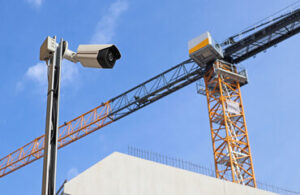Security cameras allow organizations to monitor their construction sites remotely, deter trespassers, and identify unsafe practices. These tools also aid in incident investigations and help businesses improve operational efficiency.

Choose cameras with a high resolution video capture, weather resistance, and night vision to provide optimal surveillance. Other important features include onboard storage, connectivity, and remote monitoring capabilities. Keep reading the article below to learn more about Construction Site Security Cameras.
The busy and noisy nature of construction sites makes them a tempting target for criminals. Unauthorized entry can cause damage and put lives at risk. The presence of security cameras can act as a powerful deterrent to thieves and vandals, as they signal that the area is under surveillance.
In addition to being a visual deterrent, security cameras can also detect activity on the job site. The camera will send an alert when movement is detected. This allows for faster response time and ensures that all activities are being recorded.
A good security camera system can also provide an overview of the entire construction site. This can help you identify areas that need additional security measures. It can also help you avoid overlapping coverage that may lead to blind spots or missing parts of the scene.
When selecting a security camera system for your construction site, you should look for the following features:
Image clarity
Choose cameras that offer high-definition resolution to capture crisp and clear footage. You can even opt for cameras that utilize HDR to improve image quality in low-light conditions.
Scalability
Evaluate whether the camera system is capable of expanding as the project progresses. This is especially important if you are using multiple cameras for different aspects of the project.
Cost
Consider the total cost of the camera system, including installation and maintenance costs. Be sure to balance this with your budget and desired features and capabilities.
Remote access
Opt for a camera system with remote viewing capabilities. This will enable you to access live footage from your construction site security cameras from any location with an internet connection.
Tamper detection
Choosing a camera system that offers advanced tamper detection can help prevent malicious damage or disabling of the device. This can save you from paying for costly repairs and ensures that your data is protected.
Detection of Intruders
While responsible construction firms adhere to safety regulations, accidents do happen on building sites. Security cameras can help with insurance claims by recording and documenting any incidents that take place on site. This can save time and money for both the business and the insurer.
Security camera systems that are fully integrated with video analytics can detect unauthorized access to the site, suspicious activities, and other security threats in real-time. These technologies can also automatically detect objects, such as people or vehicles, distinguishing them from background elements. This allows security personnel to quickly and efficiently respond to unauthorized activity on the construction site, minimizing the risk of theft, property damage, and injuries.
Some trespassers on construction sites are simply curious about what’s being built, but others may be looking for a way to cause harm or vandalism. Security cameras can act as a deterrent against these kinds of criminal acts by clearly displaying that the site is being monitored.
Depending on the needs of your construction site, you can opt for CCTV systems with license plate detection capabilities that can capture front and rear license plates of any vehicles that pass by. This feature can be particularly useful in cases of stolen or damaged construction equipment and materials.
For optimal security, your CCTV system should be continuously monitored by a team of security personnel. A live feed can be displayed in a central monitoring room, or you can choose a remote video surveillance solution that lets you monitor your cameras from a secure location.
To ensure that your cameras are always in working condition, make sure they have a reliable power source and regular maintenance schedules. Whether they are powered by solar, hardwire, or batteries, check all power connections and cables regularly for any signs of damage or wear. Also, consider employing uninterrupted power supply (UPS) systems to prevent the loss of power from leaving your camera system vulnerable to attack.
Choosing the right security cameras for your construction site requires careful consideration and research. The best camera for your needs will have a wide field of view and high-resolution image quality, as well as features such as night vision and line crossing detection. It will also be easy to set up and integrate with other security measures, such as access control systems, for optimal security.
Detection of Damage
Using security cameras to monitor the condition of construction sites can prevent property damage and improve employee safety. Cameras can alert managers to issues such as unauthorized entry, suspicious activity, and equipment malfunction. With this information, they can quickly respond and rectify the problem before it worsens. This can help reduce the risk of costly delays and unforeseen expenses.
Unlike traditional surveillance systems, AI-powered security cameras are more accurate at detecting a wider range of threats. The technology analyzes video feeds to recognize specific objects and people, eliminating the false alarms caused by animals, windblown debris, and shadows. It can also detect motion speed, allowing users to differentiate between an ordinary person walking and someone running suspiciously.
In addition to reducing false alarms, security cameras can improve worker productivity and efficiency by providing an effective deterrent. Studies have shown that employees will work more seriously and productively when they know their actions are being monitored. This is especially important on construction sites, where safety and quality are top priorities.
A comprehensive construction site security system should include cameras and other security measures such as perimeter fencing or access control systems. It should also be backed by dedicated security personnel to monitor and enforce protocols. Security personnel should be trained in the proper use of security cameras to ensure that they are effectively used on-site.
Additionally, it’s crucial to have a clear understanding of local laws and regulations on privacy and surveillance before installing cameras on construction sites. This can help avoid any legal entanglements. In some cases, it may be necessary to obtain a permit for the installation of cameras on construction sites. This process usually involves providing detailed plans for camera locations, data storage policies, and measures to protect the privacy of those recorded by the cameras.
In addition, it’s important to have stringent data protection measures in place to prevent unauthorized access or leaks of sensitive footage. Investing in secure storage solutions and encryption methods can help minimize risks. Also, it’s a good idea to establish a clear data retention policy and a process for erasing recordings when they are no longer needed.
Detection of Fraud
Construction site security cameras can help prevent theft by identifying the perpetrators in real-time. Unlike traditional cameras that provide blurry footage, AI infused surveillance solutions detect intrusions and alert security operators instantly. They also track the movement of the thieves or vandals. With the real-time video, security operatives can react to the situation, sending them on their way or even contacting law enforcement or fire department.
Construction Site Security Cameras can also act as a valuable documentation tool for projects, capturing the progression of work and events on the jobsite. This helps in project management, dispute resolution and legal purposes. The presence of security cameras can also foster accountability and discipline among workers, enhancing productivity.
Some security camera options offer remote monitoring capabilities, enabling project managers or security personnel to monitor the site from any location in the world. This enables faster and more efficient emergency response times, reducing the risk of property loss or further damage.
Ensure that the chosen security camera system is suited to the jobsite environment, including existing internet and network connectivity and power sources on the jobsite. Consider a solution that is compatible with access control systems, which can be integrated into the surveillance platform for seamless operation. Robust camera design, such as IP67 weather resistance and IK10 vandal-resistant features, should be considered for use in harsh environments. Dedicated, tamper-proof camera enclosures are also ideal to deter unauthorized activity.
Lastly, it is important to choose a construction security camera that can record footage continuously. While some camera models are battery or solar-powered and only activate when they detect motion, others can operate on a continuous basis and record indefinitely. The ideal solution for construction sites will feature a cloud-based management platform, such as Verkada’s Command, which enables simple and convenient remote monitoring and recording on any device. A camera that supports Power over Ethernet (PoE) for simplified cabling and maximum power efficiency is an additional benefit. This is ideal for construction sites with limited power availability. This feature will also enable the installation of additional camera devices such as an LED strobe light or loudspeaker, enhancing the security coverage on the jobsite.
